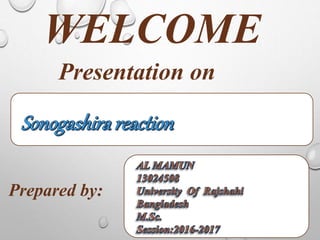
Sonogashira cross-coupling reaction
- 2. History Of Sonogashira Coupling Reaction The Sonogashira cross-coupling reaction was first reported by Kenkichi Sonogashira, Yasuo Tohda, and Nobue Hagihara in their 1975 publication. It is an extension to the Cassar and Dieck and Heck reactions, which afford the same reaction products, but use harsh reaction conditions, such as high temperature, to do so. Both of these reactions make use of a palladium catalyst to carry out the coupling, while Sonogashira uses both palladium and copper catalysts simultaneously.
- 3. This results in the increased reactivity of the reagents and the ability of the reaction to be carried out at room temperature, making the Sonogashira cross-coupling reaction a highly useful reaction, particularly in the alkynylation of aryl and alkenyl halides. The reaction's remarkable utility can be evidenced by the amount of research still being done on understanding and optimizing its synthetic capabilities.
- 4. Reaction The Sonogashira reaction is a cross-coupling reaction used in organic synthesis to form carbon–carbon bonds. It employs a palladium catalyst to form a carbon–carbon bond between a terminal alkyne and an aryl or vinyl halide.
- 5. The Sonogashira cross-coupling reaction has been employed in a wide variety of areas, due to its usefulness in the formation of carbon–carbon bonds. The reaction can be carried out under mild conditions. Like at room temperature, in aqueous media, and with a mild base, which has allowed for the use of the Sonogashira cross-coupling reaction in the synthesis of complex molecules.
- 6. Catalysts Of Reaction Typically, two catalysts are needed for this reaction : 1. Zerovalent palladium complex Examples of such palladium catalysts are (Pd(PPh3)4), Pd(PPh3)2Cl2. Bidentate ligand catalysts, such as Pd(dppe)Cl, Pd(dppp)Cl2, and Pd(dppf)Cl2 have also been used. The drawback to such catalysts is the need for high loadings of palladium (up to 5 mol %), along with a larger amount of a copper co-catalyst. PdII is often employed as a pre-catalyst since it exhibits greater stability than Pd0 over an extended period of time.
- 7. The Pd II catalyst is reduced to Pd0 in the reaction mixture by either an amine, a phosphine ligand, or a reactant, allowing the reaction to proceed. 2. Halide salt of copper(I) Such as copper iodide, react with the terminal alkyne and produce a copper(I) acetylide, which acts as an activated species for the coupling reactions. Cu(I) is a co-catalyst in the reaction, and is used to increase the rate of the reaction.
- 8. Reaction Conditions And Solvents It have already known that the reaction is carried out under mild conditions like at room temperature, in aqueous media, and with a mild base. The cross-coupling is carried out at room temperature with a base, typically an amine, such as diethyl amine. Diethyl amine that also acts as the solvent. The reaction medium must be basic to neutralize the hydrogen halide produced as the byproduct of this coupling reaction, so alkylamine compounds such as triethylamine and diethylamine are sometimes used as solvents.
- 9. DMF(Dimethylformamide) or ether can also be used as solvent. Other bases such as potassium carbonate or cesium carbonate are occasionally used. Conditions are formally needed for Sonogashira coupling reactions because the palladium(0) complexes are unstable in the air, and oxygen promotes the formation of homocoupled acetylenes. Recently, development of air-stable organopalladium catalysts enable this reaction to be conducted in the ambient atmosphere.
- 10. Mechanism The palladium cycle 1) An inactive palladium PdII catalyst is activated by a reduction to the Pd0 compound. 2) The active palladium catalyst is the 14 electron compound Pd0L2, complex A, which reacts with the aryl or vinyl halide in an oxidative addition to produce a PdII intermediate, complex B. This step is believed to be the rate-limiting step of the reaction.
- 11. Complex B reacts in a transmetallation with the copper acetylide, complex F, which is produced in the copper cycle, to give complex C, expelling the copper halide, complex G. 3) Both organic ligands are trans oriented and convert to cis in a trans-cis isomerization to produce complex D. 4) In the final step, complex D undergoes reductive elimination to produce the alkyne, with the 5)
- 12. regeneration of the palladium catalyst. The copper cycle It is suggested that the presence of base results in the formation of a pi-alkyne complex, complex E, which makes the terminal proton on the alkyne more acidic, leading to the formation of the copper acetylide, compound F. 1) Compound F continues to react with the palladium intermediate B, with regeneration of the copper halide, G. 2)
- 13. Complications Due to the crucial role of base, specific amines must be added in excess or as solvent for the reaction to proceed. It has been discovered that secondary amines such as piperidine, morpholine, or diisopropylamine in particular can react efficiently and reversibly with trans-RPdX(PPh3)2 complexes by substituting one PPh3 ligand. The equilibirium constant of this reaction is dependent on R, X, a factor for basicity, and the amine's steric hindrance.
- 14. Applications Its applications include pharmaceuticals, natural products, organic materials, and nanomaterials. Specific examples include its use in the synthesis of tazarotene, which is a treatment for psoriasis and acne, and in the preparation of SIB-1508Y, also known as Altinicline, a nicotinic receptor agonist. It has also some synthetic application like Alkynylation reactions, enynes and enediynes etc.
- 15. Limitations While a copper co-catalyst is added to the reaction to increase reactivity, the presence of copper can result in the formation of alkyne dimers. This leads to what is known as the Glaser coupling reaction, which is an undesired formation of homocoupling products of acetylene derivatives upon oxidation. As a result, when running a Sonogashira reaction with a copper co-catalyst, it is necessary to run the reaction in an inert atmosphere to avoid the unwanted dimerization. Now a days Copper-free variations to the Sonogashira reaction have been developed to avoid the formation of the homocoupling products.
